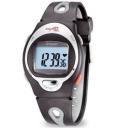How monitoring your heart rate can help your cricket training
This guest post is by Liz Ward
Although the game takes such a long time, the average cricketer spends most of their time not doing very much at all.
However, when they are called into action it is, more often than not, explosively: Sprinting to bag that catch, sprinting to save that four, charging up the wicket, charging up again only to get half way up and having to perform a miraculous, momentum defying, 180 degree about turn to get back to safety!
The physiological demands of intermittent activity sports, such as cricket, are generally misunderstood. If you were to analyse your movements during the average game, you would see that there is very little endurance work taking place, other than with your core and mental toughness.
It is easy enough to train for this and for those starting out, a heart rate monitor can help you get the feel of the different intensities and there are many inexpensive models on the market these days. Some gyms also have a few on hand to loan out to their members.
See the amazon link below for some examples to buy:
Maximum Heart Rate
Once you have your monitor, the first step is to calculate your maximum heart rate (MHR). This is the maximum number of contractions, or heart beats, in one minute, that your heart should achieve during maximal physical exertion.
It is generally accepted that this is closely linked to your age, declining as you get older, which is where the ‘220 minus age in years' method of determining MHR comes from. However, this method is considerably biased as the principle suggests that your MHR declines one beat per minute, per year. In fact Per Olof Astrand, a Swedish scientist, considers that MHR declines at different rates for males and females: 9 bpm in 21 years/26 bpm in 33 years and 12 bpm in 21 years/19 bpm in 33 years, respectively.
The above method works well if you are 40, then MHR = 220 – 40 = 180; as accurate as it can be but as the age moves away from this point, in either direction, this calculation is skewed; underestimating the optimum heart rate training zones as you get older and overestimating them the younger you are (see table below).
There are quite a few other methods for determining MHR around but this is the most accurate formula I have worked with recently; devised by a US team involved in MHR research over a 25 year period:
It is worth remembering though, that there can still be a small standard of error.
Heart Rate Workouts for Cricket
 Once your MHR has been ascertained, you can now work out your preferred training zone. As discussed above, a cricketer should be working towards the 'Explosive Zone' (90-100% MHR zone). Training at this level stimulates the fast twitch muscle fibres and improves the anaerobic pathways. It increases the muscles' tolerance to large amounts of lactic acid and improves sprinting ability; both the nervous and muscular systems become accustomed and more efficient at higher muscular contraction rates.
Once your MHR has been ascertained, you can now work out your preferred training zone. As discussed above, a cricketer should be working towards the 'Explosive Zone' (90-100% MHR zone). Training at this level stimulates the fast twitch muscle fibres and improves the anaerobic pathways. It increases the muscles' tolerance to large amounts of lactic acid and improves sprinting ability; both the nervous and muscular systems become accustomed and more efficient at higher muscular contraction rates.
The best training method to use would be high intensity intervals; repeated all-out sprints of 10-60 second durations with recovery periods two or three times the duration of the work period. This can be done either on a treadmill or sprints around the ground.
You should aim for 10 second exercise durations at 100% MHR with a work/rest ratio of 1:3, for 20-30 intervals. However, start with 30 second durations for 8-18 intervals, progressing to 20 second durations for 10-20 intervals.
Alternatively, mark out a 120m track with cones; divided into three 40m lengths. Once you have increased your intensity to a consistent 80-90% MHR, run the first 40m at this intensity, increase intensity to 100% MHR for the next 40m then bring it back down to 80-90% MHR for the last 40m. Turn and repeat; aiming for 20-30 intervals. This has the added benefit of training deceleration and 180 degree turns on the hoof and is a lot easier to practice if you are not training with a partner.
These are extremely demanding workouts, designed to boost neuromuscular efficiency so when you structure such a session into your weekly programme, it is vitally important that you allow sufficient time for your muscles to recover. Delayed onset muscle soreness (DOMS) is to be expected at this training level so you should ensure you complete an effective cool down immediately after the session with a very good stretch out of all the major muscles involved in the workout.
I cannot stress enough the necessity to build up to this level and anybody not currently involved in fitness training should consult their GP before embarking on such a high intensity programme.
About the author
Liz Ward is a Strength and Conditioning Practitioner operating in and around Essex, Cambridgeshire, Hertfordshire and Suffolk with a mission to change the way cricketers train for the sport; introducing biomechanics, fitness, psychology and nutrition.
If you would like a consultation you can email Liz at e.k.ward@btinternet.com. Liz is also a consultant coach on the Simplycricket Fitness and Nutrition forum.
- Login to post comments


Comments
sir, i am best boweler. I want to play cricket. What can i do sir to join this